Having a robust stockpile of seeds can save your life in a prolonged catastrophe. There are certainly tons of companies selling high-quality curated seed stockpiles that agree.
Yet how you store your seed stockpile, and the kinds of seeds you prioritize matter. Especially since some herb and vegetable seeds like onions, parsley, and lettuce might only remain viable for 1 to 3 years, while other seeds like beans, tomatoes, peppers, and winter squash can remain viable for 5 to as much as 10 years.
You also need to choose seeds that will give you a second generation from the plants that do bear fruit. You also need to consider just how much growing space you have in your garden, the labor it takes to grow, and how the fruit they bear can be stored.
Not to worry. I’ve been saving and storing seeds since Grandma first started teaching me to garden back in 1978. I’m going to give you what you need to know whether you want to buy a carefully curated seed stockpile or start one on your own.
Creating Ideal Storage Conditions
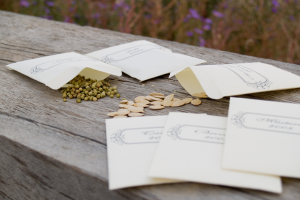 Even the best seed stockpile is useless if you can’t properly store it in a way that maximizes the germination viability of each type of seed. On paper, this means storing seeds in a sealed container in a cool, dry location without direct sunlight exposure.
Even the best seed stockpile is useless if you can’t properly store it in a way that maximizes the germination viability of each type of seed. On paper, this means storing seeds in a sealed container in a cool, dry location without direct sunlight exposure.
In a prepping situation, this means storing the seeds in air-tight, vacuum-sealed bags.
If you’re building your seed stockpile you also have to put extra effort into properly drying them. Moisture on and in the seeds can lead to mold development. It can also break down the delicate starch chemistry inside the seed that it needs to germinate vigorously.
Ideally, you want to store them at a consistent temperature between 40 to 50 degrees Fahrenheit. Temps over 65 degrees can start to affect the germination rate, and many seeds rapidly lose their viability in temps approaching 90 degrees. The perfect storage space for seeds but also your entire stockpile is this cellar you can make in your backyard to protect both your supplies and even your life in a crisis. Here are the step-by-step instructions on how to make it fast and cheap.
You also need to avoid freezing temps, as it can turn the residual water in the seeds into ice crystals that damage the structures of the seed. Prolonged time in freezing temps can also cause ice crystals to grow, creating microscopic punctures in the air-tight bag.
An Easy Seed Storage System
Setting aside a separate space in your root cellar or basement for your seed stockpile keeps it safe and ensures temperature stability.
You could put each sealed bag in a small box to keep it from getting crushed by the weight of other seeds or something else being accidentally placed on top of it.
Related: How To Harvest These Seeds For SHTF
I like to keep one stockpile for long-term storage, and another stockpile of heirloom/open-pollinated seeds that I plant year after year. In the fall, I’ll save a ton of seeds from a vegetable I grew that year and place a big bag of them in long-term storage. This ensures I always have viable seeds for a catastrophic moment, and seeds for next year’s garden.
Growing Your Own Seed Stockpile vs Buying It
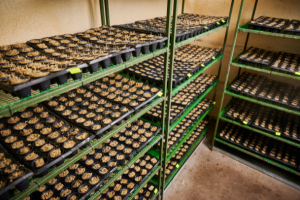 If you need a big seed stockpile fast, the easiest way is to buy one online.
If you need a big seed stockpile fast, the easiest way is to buy one online.
There are some good ones out there, but you’re probably going to overpay for them, and there’s no rock-solid guarantee on just how long they’ll last in storage.
You also have to have your own storage system set up to maximize the viability of those seeds in the long term.
So, you shouldn’t think of them as being permanently in the bank. While you might get a 10-year-old bean, tomato, and pepper seeds to germinate, the wise move is to periodically refresh your seed stockpile with fresh seeds from your own garden. Think of how our ancestors cultivated the land or how the Amish people still grow all their food. This is a great resource to find out how they do it.
The other advantage of growing your own seed stockpile is that you are also refining your skills as a gardener. Gardening is not as easy as simply tossing some seeds on some dirt in hopes of harvesting a salad a few weeks later.
There are a lot of techniques and planting strategies. Not to mention no two sites have the same soil conditions, light exposure, or the risk of pests and plant diseases.
The best strategy might be to buy a robust seed stockpile today to make sure you’ve got it. Then add fresh seeds to it year after year. Paying attention to the age of specific seeds in your main stockpile. When they start getting to the end of their viability, you plant them to refresh their presence in the seed stockpile.
Heirloom vs Open Pollinated vs Hybrid Seeds
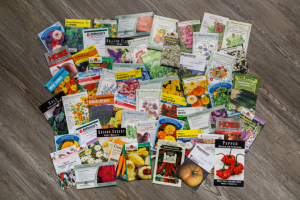 In gardening parlance, you often hear the word Heirloom being used to describe any old-time seed, fruit, or vegetable.
In gardening parlance, you often hear the word Heirloom being used to describe any old-time seed, fruit, or vegetable.
Heirloom seeds are technically open-pollinated plants that can provide viable seeds in the next generation and have a history that can be traced back to 1940 or earlier.
The term open-pollinated means the same thing as heirloom, except the history of the seed is from 1940 or later. So, all heirloom vegetables are open-pollinated seeds. They just have a bit of a story to them.
Hybrid seeds are created by botanists and agronomists by crossing two different types of the same plant to create one with the best possible traits. This will give you a plant that usually has superior disease resistance and will give you a big harvest of fruits that will last longer in storage than most heirloom varieties. Most of the things I apply on my own property these days are from this book that shows you how you can feed yourself and your family in times of crisis using some very simple techniques.
Unfortunately, hybrid plants rarely produce enough viable seeds to be sustainable. Even if you do get a small percentage of seeds that do germinate, the plants that grow will have defects and might not live long enough to produce fruit.
Bottomline
When shopping for your seed stockpile you want to make sure the varieties inside are open-pollinated or heirloom. Otherwise, you’ll only get a single year of production out of them and be left with unexpected hard times in year two!
Seed Viability Time
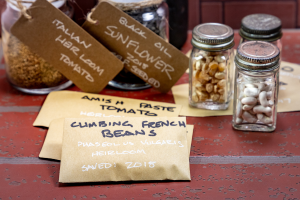 As I mentioned earlier, some types of seed last longer than others, and you can expect their germination rate percentage to decline over time.
As I mentioned earlier, some types of seed last longer than others, and you can expect their germination rate percentage to decline over time.
You want to take this into account when shopping for a seed stockpile or coming up with a strategy when developing your own.
The rule of thumb I’ve adopted over the years is to always grow some of a seed that has reached 50% of its average seed viability life. A bean variety that has an average viability of 10 years, will be replanted at least every 5 years.
Average Viability for Common Types of Seeds
The following is the average viability for common types of seeds you find in most curated and custom seed stockpiles.

Nutrient Value
With any curated or personal seed stockpile, you also need to factor in the nutrient value of the varieties you intend to grow.

This sometimes conflicts with seed viability. So, you might want to treat it like a VEN diagram.
When choosing a seed stockpile that prioritizes nutrient value, you want to look for these highly nutritious herbs and vegetables.
The more nutritious your food is, the more you can count on your stockpile in times of crisis. A good way to keep all the nutrients in your vegetables is a method that shows you how to make food long-lasting and store it without refrigeration.
Kale & Collards both have a high amount of A, C, and K, as well as minerals like manganese and copper. They’re also a good source of antioxidants and fiber.
Spinach is high in A, C, and K, as well as folate, iron, and calcium, spinach is a powerhouse of nutrients and antioxidants.
Broccoli & Cauliflower both have a high amount of vitamins A, C K, and folate, along with healthy levels of potassium and manganese.
Carrots have long been prized as a source of natural sugar while also being rich in beta-carotene, and high in vitamins C and K, as well as fiber.
Peas are a good source of vitamins C and E, as well as zinc.
Beets are a good source of iron fiber, folate, manganese, and potassium.
Cabbage and Brussels sprouts have high amounts of vitamins C and K, as well as antioxidants. They’re also a good source of dietary fiber.
Peppers have high levels of vitamin C and antioxidants. They also contain vitamin A and vitamin B6. Hot/spicy peppers can also be used as a preservative.
Tomatoes are a good source of lycopene antioxidants, as well as vitamins C and K, potassium, and folate.
Effort to Grow & Usefulness
Just how much work goes into growing the vegetables you’ll grow from your seed stockpile, and the purposes they serve are also factors you must consider. You have to remember that in the end, it’s about creating a net calorie surplus in your body.
Brussel spouts are a notoriously labor-intensive vegetable that requires a lot of tending, watering, pest prevention, and pruning. They also take a long time to go from seed to harvest.
Whereas leafy greens like lettuce, kale, and collards all provide you with nutrient-rich foods that are easy to grow. Root vegetables like carrots are also very easy to grow, nutrient-dense, and have very few pests.
Related: Do Seeds Really Expire?
Zucchini, cucumbers, and beans are also great vining plants that require minimal maintenance. Yet they provide you with a good yield that you can enjoy fresh during the season and then pickle or put up in the fall.
Storage Potential of the Vegetables

When choosing the best seed stockpile for your prepping strategy you also need to consider how much work goes into storing them and how long they keep in storage.
This can fly in the face of the ease of harvesting.
For example, lettuce doesn’t dry well and isn’t viable for long-term storage. Canning spinach causes a significant nutrient loss and affects the quality.
Winter squash can be put up properly for many months, but likely won’t make it beyond next spring.
Tomatoes, peppers, zucchini, and cucumbers can all be easily canned or pickled. While this might reduce their overall nutrient value, it can extend their storage potential for two years or more! And, as I mentioned earlier, having a good cellar that you can build yourself without too much effort is the best choice for storing your entire stockpile.
Available Space
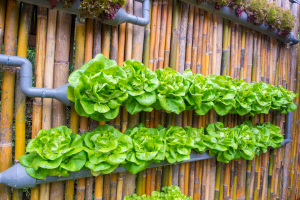 The space a seed stockpile takes up in storage isn’t as much of a factor as the space the actual vegetables and herbs will take up in your garden or fields.
The space a seed stockpile takes up in storage isn’t as much of a factor as the space the actual vegetables and herbs will take up in your garden or fields.
If you only have a small plot, you might want to prioritize seeds that vine out to grow vertically.
Peas, beans, zucchini, and cucumbers can be grown on trellises, and become a high priority when choosing a seed stockpile for a garden with limited growing space.
Whereas winter squash, pumpkins, and melons with their sprawling vines are only a good idea if you have a large garden. For those who are serious about surviving whatever comes their way and whatever the space they have, I strongly recommend this comprehensive guide. It offers invaluable insights and practical advice for transforming your backyard into a self-sustaining homestead.
Pollination Requirements
A thoughtfully selected seed stockpile should also account for the pollination needs of the plants it will eventually grow. If your region is known for having a low population of beneficial pollinators, or you’re prepping specifically to survive a nuclear disaster, you might want to avoid vegetables that need cross-pollination.
Self-pollinating vegetables like tomatoes, peppers, eggplants, and green beans don’t require insects to pollinate them. Herbs generally don’t need cross-pollinating to produce seeds but may benefit from having multiple plants of the same type grown nearby.
Insect-pollinated vegetables like cucumbers, most melons, winter squash, and summer squash need insects to pollinate them. You might be able to manually hand-pollinate them with cotton swabs, but the percentage of viable fruit will be 50 to 75%.
Wind-pollinated crops like corn, wheat, oats, barley, and rye rely on a specific planting density to ensure complete pollination. They tend to be very hard to properly hand pollinate, which makes them a poor choice for a seed stockpile with a limited growing area.
While stockpiling vegetable seeds seems like the obvious step when preparing for a food crisis, I strongly recommend stockpiling some medicinal seeds as well. You can get them from here and grow your own supply of natural remedies. These plants can help with many common ailments and even save lives in an emergency. You can buy packets of medicinal herb seeds for cheap, and they will pay dividends and become invaluable in a crisis when access to medications is scarce.
You may also like:
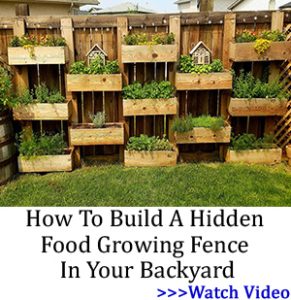 How to Become Invisible to FEMA in a Crisis
How to Become Invisible to FEMA in a Crisis
The Only Food That Grows Almost Faster Than You Can Eat It (Video)
Have You Been Using Fake Honey?
The Black Walnut Hull Remedy That Cleans Your Intestines Of Parasites

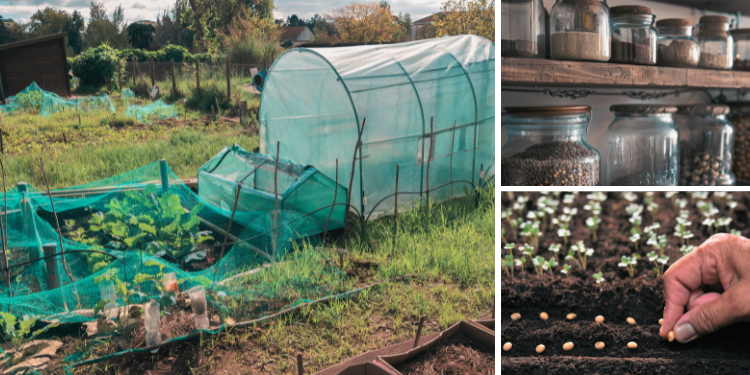




















The book “Seed to Seed” by Suzanne Ashworth is my chief resource for seed saving. Clearly written, concise, and easily understood. Saving seed is like anything else, you have to actually do it to find what works best for you as there is a learning curve.
A couple of things. First I did not see mentioned things like carrots take two years to produce seeds. They most winter over for a year to produce seeds. There are others do your research.
Second, seeds can be frozen if done right. There are I believe two major seed banks in the world that have, last I read over 900,000 varieties of seeds in frozen states. One of these is in Norway and the entrance looks like a vault, because it is. Te first freeze dry the seeds and then freeze them in storage. The freeze drying removes between 90 to 100% of the moisture so the seeds stay good. By the way one of the security system in Norway is Polar Bears.
we have always frozen our seeds and have never had a problem.
Another thing to consider is that some seeds will easily cross-pollinate with other similar seeds. Not a problem if you don’t want to save seeds, but can mean growing a different type of veg if you do. Melons and squashes are notorious examples of this. So if you have a small plot only, growing one variety each gardening season would keep the seed purity.
A little off-topic, but consider what’s growing wild around your place and consider if that can substitute for a garden item. For instance if you have nettles, they can be eaten as greens around the same time you’d be eating spinach. Then the space you’d have given to spinach can go for something else.
Besides considering nutritional value, also look at caloric count. Pumpkin or winter squash have more calories than greens. In a survival situation, pumpkin or a bowl of bean soup will fill the belly better than a large spinach salad.
Also, make sure you label your seeds well. If you are busily harvesting, preserving, and saving seeds, you might set down some seeds thinking you’ll store them later, then realize you didn’t label them, so it’s a guess later on. I had one year of that with bean seeds. I had planted out an old package and some newer seed. They were both green beans. I had also planted some wax beans. The wax beans were brown seeds, and the green beans mostly white. But the older package had some beans that were a creamier, lighter tan color.
Next season, I grew out the unlabelled beans. I grew the white seeds together, the tan seeds together, and the brown seeds together. Some of the brown seeds gave me green beans rather than wax beans.
No harm done, as I like and use both. But it underscored for me the importance of taking the time of labelling my seeds.
This article is definitely a saver. I have learned so much reading this website and the comments section over the years and for this City Chick, the info is priceless.
Stockpiling seeds is a smart way to stay prepared and ensure a thriving garden year-round! A great investment in future harvests. Keep Writing More
This was very usefull information for us because your explanation is so amazing. please keep write the blogs.